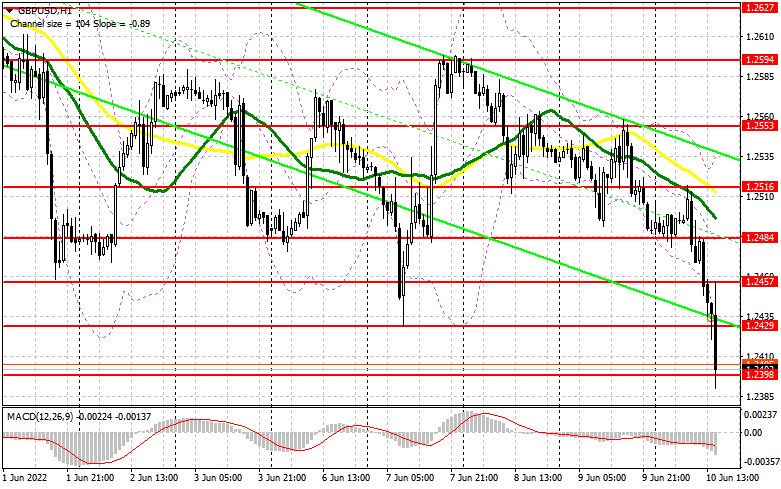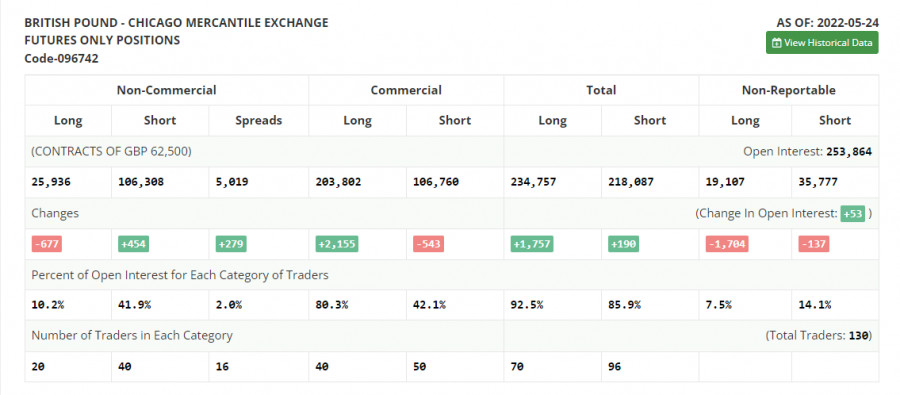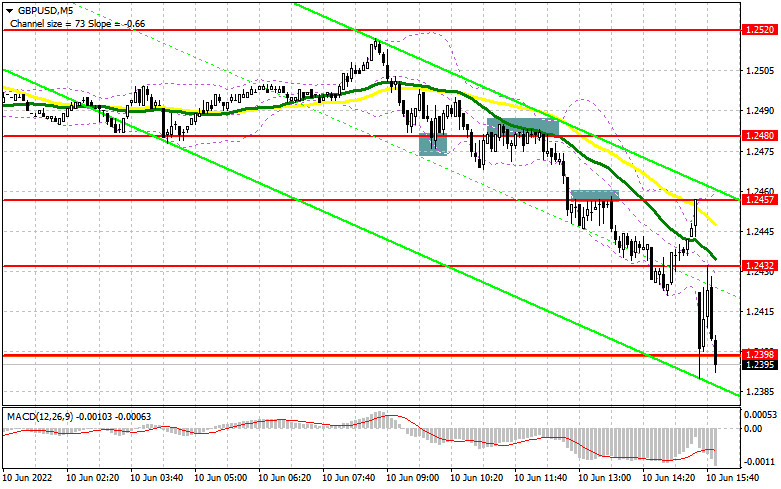In my morning forecast, I paid attention to the level of 1.2480 and recommended making decisions on entering the market. Let's look at the 5-minute chart and figure out what happened. A false breakout in the first half of the day led to a signal to open long positions, but the normal upward movement did not take place. After some time, the bears regained control over 1.2480, and a reverse test from the bottom up led to a sell signal. As a result, the pound quickly fell to 1.2457 and consolidated lower, giving an additional signal for short positions. Already after the US data, the pound collapsed to the area of 1.2389, allowing more than 100 points of profit to be taken from the market. And what were the entry points for the euro this morning?
To open long positions on GBP/USD, you need:
Buyers of the pound have nothing to count on today, so it's better not to rush to find the bottom - obviously, it won't be today. Only the formation of a false breakdown at 1.2398 will lead to the first signal to open long positions in the calculation of an upward rebound at the end of the week. An equally important task for the bulls in the afternoon will be to return the resistance of 1.2429 under control, which will be quite difficult to do in the current conditions when there will be a lot of people willing to sell the pound with each growth. A breakout and a reverse top-down test of 1.2429 will reduce the pressure and allow you to get out to 1.2457 and 1.2484, where I recommend fixing the profits. In the event of a further decline in the pound, which is more likely, as well as the absence of buyers at 1.2398, the pressure on the pair will increase. This will open the road to 1.2371. For this reason, I advise you not to rush purchasing. It is best to enter the market after a false breakdown at this level. I do not advise buying GBP/USD immediately on the bounce, only false breakouts in the area of 1.2331 and 1.2280 will allow you to count on a correction of 30-35 points within a day.
To open short positions on GBP/USD, you need:
Of course, the formation of a false breakout at 1.2429 would be an ideal scenario for those who did not have time to sell the pound in the first half of the day. For this reason, I recommend focusing on 1.2429. If the bears push through 1.2398, then the reverse test from the bottom up of this range, by analogy with what I analyzed above, will form an additional sell signal, allowing GBP/USD to fall into the area of 1.2371, from which there is a direct road to 1.2331, where I recommend fixing the profits. The longer-range target will be a minimum of 1.2280. With the option of GBP/USD growth and lack of activity at 1.2429, an upward jerk may occur against the background of the demolition of stop orders at the end of the week. In this case, I advise you to postpone short positions until 1.2457. I advise you to sell the pound there only if there is a false breakdown. Short positions can be made immediately for a rebound from 1.2484, or even higher - from 1.2516, counting on the pair's rebound down by 30-35 points inside the day.

The COT report (Commitment of Traders) for May 24 recorded a reduction in long positions and an increase in short ones. However, this did not significantly affect the balance of power. Despite the growth of the pound since the middle of this month, the market remains completely under the control of sellers. Only the lack of fundamental statistics, to which the pair have been reacting quite negatively lately, and small profit-taking from annual lows allowed GBP/USD to recover a little. There are no other objective reasons for growth. The economy continues to slide into recession, inflation is breaking new records, and the cost of living in the UK is steadily rising. The Bank of England continues to rush between two fires, but even despite all this, the governor of the Bank of England, Andrew Bailey, continues to say that the regulator is not going to give up on raising interest rates yet. Rumors spread that the US Central Bank plans to pause the cycle of interest rate hikes as early as September of this year continues to gain momentum, which puts little pressure on the US dollar and leads to a strengthening of the pound. The COT report for May 24 indicated that long non-commercial positions decreased by -667, to the level of 25,936, while short non-commercial positions increased by 454, to the level of 106,308. This led to an increase in the negative value of the non-commercial net position from the level of -79,241 to the level of -80,372. The weekly closing price rose from 1.2481 to 1.2511.

Signals of indicators:Moving averagesTrading is conducted below 30 and 50 daily moving averages, which indicates the development of a bearish market scenario.Note. The period and prices of moving averages are considered by the author on the hourly chart H1 and differ from the general definition of the classic daily moving averages on the daily chart D1.Bollinger BandsIn the case of growth, the upper limit of the indicator in the area of 1.2553 will act as resistance.Description of indicators
- Moving average (moving average determines the current trend by smoothing out volatility and noise). Period 50. The graph is marked in yellow.
- Moving average (moving average determines the current trend by smoothing out volatility and noise). Period 30. The graph is marked in green.
- MACD indicator (Moving Average Convergence / Divergence - moving average convergence/divergence) Fast EMA period 12. Slow EMA period 26. SMA period 9
- Bollinger Bands (Bollinger Bands). Period 20
- Non-profit speculative traders, such as individual traders, hedge funds, and large institutions use the futures market for speculative purposes and to meet certain requirements.
- Long non-commercial positions represent the total long open position of non-commercial traders.
- Short non-commercial positions represent the total short open position of non-commercial traders.
- Total non-commercial net position is the difference between the short and long positions of non-commercial traders.















